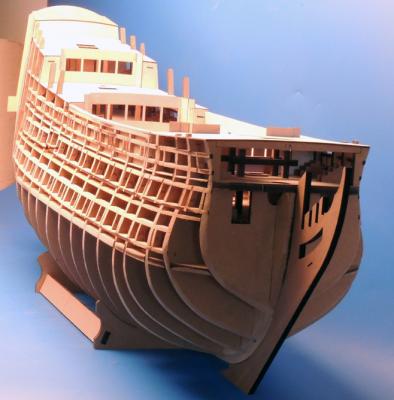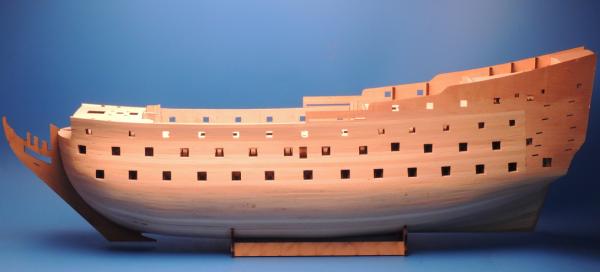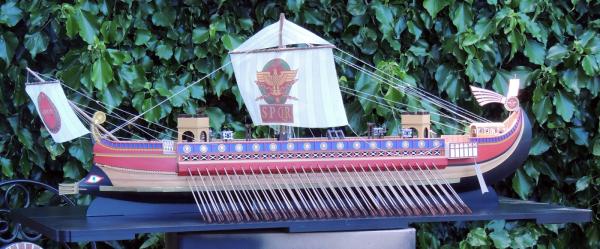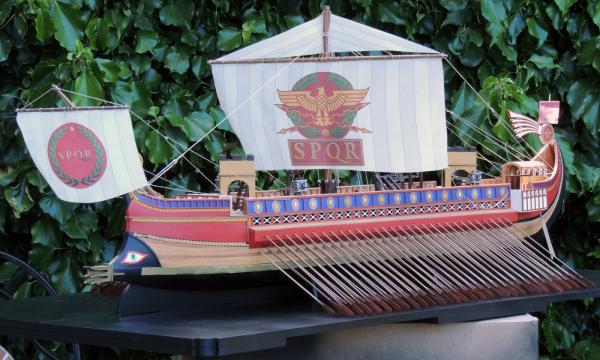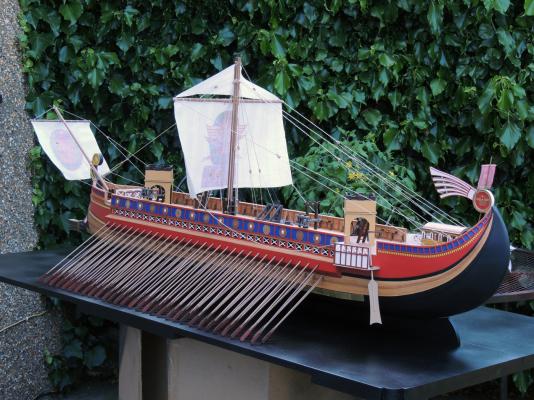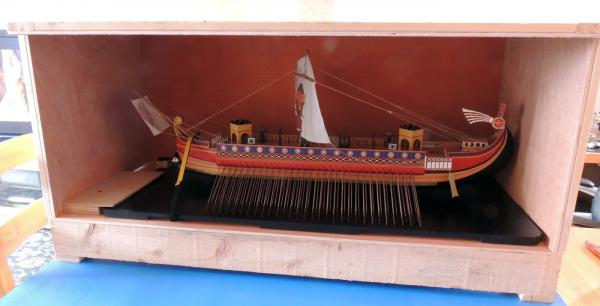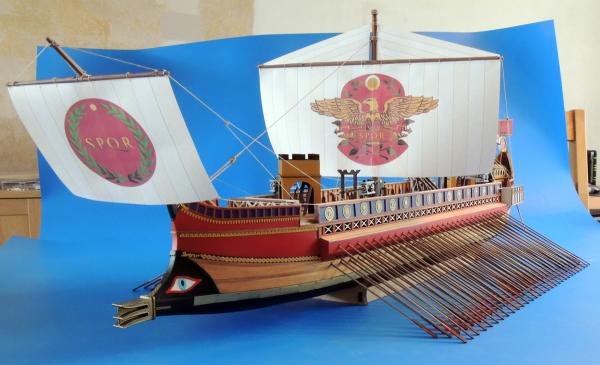-
Posts
2,331 -
Joined
-
Last visited
Content Type
Profiles
Forums
Gallery
Events
Everything posted by chris watton
-
Hi! Sorry I haven't been on here for a while. In the day my time is take up working for Amati and in the evenings I am busy trying to keep fit, after deciding that I needed to lose weight a couple of years ago.. As Anja wrote, Victory is complete and took me longer to finish than I thought. It was new territory for me as I haven't designed anything this complex before, and the plans and instructions reflected this. (31 full size plan sheets and a 114 page instruction manual (A3 size) containing well over 1000 line drawings and photographs). It came to a point where I thought I'd never finish this. but I was very conscious of the fact that it was no good designing such a detailed and complex kit and not putting in the time to make the plans and instructions as thorough as they can be. I have just completed a little modeller's manual, which Amati asked me to do, which I submitted only a couple of weeks ago. I am now working on Prince after having re-designed it for a third time after the lessons learned designing Victory - I am awaiting the brand new carvings. And that's where I am up to. Thank you, Chris
-
Hi Jan, I know for a fact that Amati are working hard to get Revenge released ASAP, so it shouldn't be too long. (Please rare in mind that I am almost 1000 miles away from Amati, so am not sure what goes on there day-to-day - I only know Revenge is imminent because of the last minute emails I recieve, asking for final clarification on some parts) keith, I think they got the scale wrong on Prince all those year's ago, I think it's really as simple as that. I used the drawings/lines taken off the original dockyard model, scaled them down from 48th to 64th and that's was the basis for the new Prince (And Van De Velde drawings for details of the actual Prince). Apart from size, almost everything was wrong with the original Amati model.
-
Prince is 64th scale, same as Victory, but being almost 100 year's older, it is somewhat smaller. In fact, it is almost identical in length to the old original Amati Prince (which was given a scale of 1:78...). So no larger than the kit that was available over 40 year's ago! (Just a little more accurate and, hopefully, a lot easier to build). Also, because of the spritsail topmast and no long mizzen boom protruding over the stern, it is a lot shorter than Victory. As for Victory, there are many kits available at smaller scales, but I think this is the first at 64th and to have full lower decks detail, complete with a full compliment of cannon and scale carriages.
-
It's been a while. I was working on Victory, but then I was sent my new designs for the Prince in laser cut and PE parts, so I figuered I'd build up the prince hull first, so that I can courier the hull over to Amati. They will then get a very good carver to make all new carvings for the model, have them cast, and then send me back the hull and loose catings. I can then continue, and finally finish the Prince! When the prince is with Amati, I shall complete the Victory drawings/plans/instructions, which should be no later than Summer. I know Amati are keen to finalise both Prince and Victory, and I am hoping Victory will be ready for release either late this year or very early next. I have attached a couple of pics of Prince in progress. I have just completed the first planking. I re-done the designs to include three more main bulkheads, (almost) full length decks from lover gun deck upwards, and the new gun port designs that are now intergeral to the hull, rather than the 1mm ply gun port patterns of the old design.
-
Bellona will be released one day, I have no doubt. What I am saying it that it needs a re-design to make the hull assembly easier to assemble, and it needs to be stronger. As it is now, I have no doubt experienced model makers would have no trouble, but for the rest, it would be a nightmare for them (I can only imagine how many emails a day I would get forwarded by Amati from customers asking for help)! I just need to design out the fragility, and once that's done, it should be fine as the rest of the parts are fine. Bellona was designed to try out new ways of building the hull with much more internal detail. from that experience I was able to design Victory with full internal detail. This was part of the point of Bellona - a test-bed for new ideas. If I still had to design the same old boring block-type models, instead of trying out new stuff, I would have gone mad with boredom by now!
-
Cheers Jaxboat The wiener's (or sausage dogs, as we call them) do help in me keeping sane - they're usually up to something that makes me laugh out loud! Have no pics to post, as I have no models here at home at all right now - not one! (Apart from a lot of unopened plastic kits, which I never seem to have the time to start...) Will keep you updated on all the stuff I am doing, especially Victory. If I add less text to the instructions, the quicker the final stages of development are, due to less translating. I know Amati have invested a hell of a lot of money in the development of this model, so I cannot envisage them sitting on this once the plans/instructions/photo booklet have been finalised. Chris
-
The Revenge should be due for release this year, as I know Amati have been working on finalising the Italian translations of my text. They are still on their Summer holidays right now, though (whole of July and August!) Right now, I am working on the 64th scale Victory plans (masts and spars). I have about another three months (at least) of work for the booklets, plans and instructions, as the model is so detailed (although I am bound to make a mistake, which someone will be only too pleased to point out at some stage... lol) Bellona is a fine looking model, and I think would sell very well, but I need to re-design a lot of the parts, following the knowledge gained while designing Victory (which was an improvement of the Bellona designs) After Victory, I would like Amati to allow me to concentrate on the 64th scale Prince, as I have re designed that in-line with the new hull construction methods I use (like Victory) Not sure about an Admiralty-type model. As much as I would like to design one, I think the perceived complexity may put off all but the most experienced - and those that can would probably be experienced enough to build their own from plans anyway. Plus, of course, the edges of the exposed frames would be black, from the laser cutting....
-
Yes, it's probably down to what you're used to, I did used to smile when the people at Amati asked why I don't use any of their tools.... I am bull at a gate - the amount of times I have gone into something head first and made a mess/right cock-up, and then pray to God after the fact to please not have made that happen.. I guess I am good at covering up my own silly mistakes.
-
I started off using scalpel blades, as this was what all the books and magazines advised. but I always found them to be a little too flimsy at least for me, and they bent too easily, sometimes even breaking/snapping off, with the end of the blade flying all over the place - Perhaps it's more to do with my bull-at-a-gate style of modelling...
-
I hardly use any at all. Just have my trusty Stanley knife (craft knives aren't really strong enough..), steel rule, pair of small pliers (mainly for temporarily fixing pins into first planking), tweezers, drill and drill bitts, small plane, razor saw - and that's about it! On a personal level, I have never really seen the point of 'modelling' tools - but that may have something to do with not being able to afford them when I first started modelling, and just got used to using standard everyday tools.... As a main tool, I still find the Stanley knife hard to beat, even after 2 decades...
-
Cheers, I have contemplated to a 32nd scale Royal Caroline in the past - would make a great model... Today, the Roman Quinquereme was delivered to the couriers in Gloucester, to be shipped to Italy - our home is once again free of any models! I did design two versions, one for the Republican period (which is how the model is displayed), and an Imperial version (Augustan). I had to design quite a substantial display base for it, as the oars make the width half a metre!
-
Cheers I didn't like the all painted hull, and couldn't sleep well until I changed it! The oars don't take too long to make at all - you just cut the dowel to length and simply glue on the laser cut paddle on the end! I can see now why most other commercial kits only show one bank of oars... I think I will have to design a base that's wide enough for the oars, as they will ne quite delicate...
-
The plans I used were actually drawn years ago and were purchased from the NMM, so I didn't take the lines off the model myself. All you do get is hull lines (including bulkheads) - but for the new designs I did, there weren't enough bulkhead lines in the plans, so I had to add a few myself. The plans were 48th scale, and trust me, the model would be way too big for this scale. At 64th, I find it a perfect size, although perhaps a little too large for some modellers - the hull is a lot larger than say, the Vanguard kit and only smaller than the 64th scale Victory (about the same depth/height, but obviously a little narrower and shorter, with Prince being 100 years older). I don't think the original Prince would have been substantially smaller than Royal William - but also you have to treat with caution the stated scales on older Italian kits - the original Amati Prince was stated as 78th scale, but my new designs have the length almost the same at 64th as the stated 78th scale original (although there's so much wrong with the original it shouldn't even be called Prince - hull shape and profiles are very different). I am sure the Italians used to use 'ballpark figures' for scales...
-
I actually started off by buying and using the plans from the full size Greek trireme. However, after buying more resource material, I quickly realised that if I were to follow the trireme plans, I would be designing a ship that would be the equivalent of using a set of medieval cog plans as the basis to build a late 18th Century ship of the line! There is almost 500 years difference in age. The more I read, the more I realised just how much these vessels changed, much of it via battle experience. The Quinqueremes at the beginning of the 1st Century AD were the equivalents of the ship of the line, and quite large and built for both offensive and defensive duties (although with the Romans, usually offensive...) - but once Rome conquered the Mediterranean, such large vessels became obsolete (as there were no more real enemies to fight) and only smaller vessels were usually built. I thought it would be good to try and design this type as it represents a Roman warship at its absolute prime, and wouldn't have looked out of place at the battle of Actium.
About us
Modelshipworld - Advancing Ship Modeling through Research
SSL Secured
Your security is important for us so this Website is SSL-Secured
NRG Mailing Address
Nautical Research Guild
237 South Lincoln Street
Westmont IL, 60559-1917
Model Ship World ® and the MSW logo are Registered Trademarks, and belong to the Nautical Research Guild (United States Patent and Trademark Office: No. 6,929,264 & No. 6,929,274, registered Dec. 20, 2022)
Helpful Links
About the NRG
If you enjoy building ship models that are historically accurate as well as beautiful, then The Nautical Research Guild (NRG) is just right for you.
The Guild is a non-profit educational organization whose mission is to “Advance Ship Modeling Through Research”. We provide support to our members in their efforts to raise the quality of their model ships.
The Nautical Research Guild has published our world-renowned quarterly magazine, The Nautical Research Journal, since 1955. The pages of the Journal are full of articles by accomplished ship modelers who show you how they create those exquisite details on their models, and by maritime historians who show you the correct details to build. The Journal is available in both print and digital editions. Go to the NRG web site (www.thenrg.org) to download a complimentary digital copy of the Journal. The NRG also publishes plan sets, books and compilations of back issues of the Journal and the former Ships in Scale and Model Ship Builder magazines.




